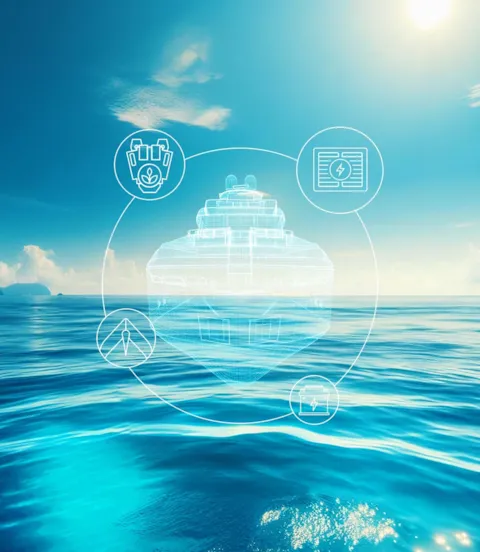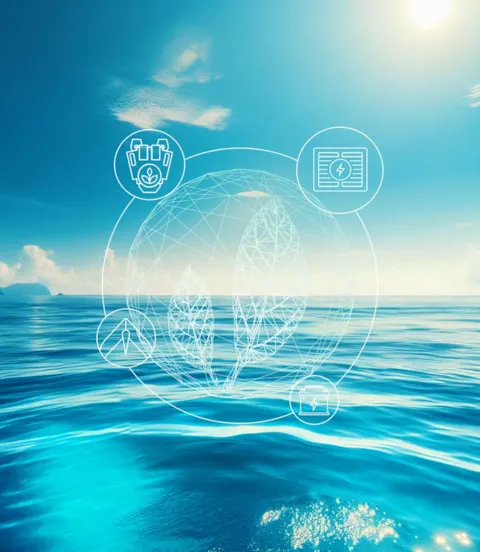Optimizing yacht designs for maximum efficiency
Today’s quality standards for yachts include efficiency criteria such as a hull design optimized for energy efficiency, low noise and vibration, structural stability, and good seakeeping. DNV provides comprehensive expertise in writing up specifications that will stand up to the test.
Luxury yachts differ from merchant ships in several respects: as leisure craft, their purpose is not to transport as much cargo as possible at the lowest cost possible; in most cases, they are not expected to operate as many days per year as possible; and their design is primarily of an aesthetic nature.
Scrutinizing design specifications
Yet, yacht design must address some of the same basic physical facts that apply to the operational fitness of any vessel. “When DNV verifies and contributes specifications for a new yacht design, a wide variety of criteria must be assessed,” explains Dr Karsten Hochkirch, Head of DNV’s Ship Performance Center. “These include good seakeeping properties, and minimized machinery- and wave-induced vibrations as well as noise that are crucial for a pleasant on-board experience. Assuring structural stability is essential for the safety of the passengers and crew. Fuel efficiency, while not necessarily a top concern for a luxury craft, determines the cruising range and tank capacity – in other words, how much space on board is needed for fuel tanks and how far the vessel can travel before it needs to call at a port for refuelling.”

Fuel efficiency is a quality characteristic
“In fact, minimizing fuel tank volumes leaves more space for other features, thereby enhancing the passenger experience while reducing the weight of the fuel carried and increasing the designer’s flexibility in terms of weight distribution,” says Hochkirch. Furthermore, the carbon footprint of any ship, whether commercial or not, is an issue of growing importance: owners are increasingly interested in protecting the natural wonders they enjoy visiting, and public awareness as well as emission regulations, especially in ports of touristic interest, are good reasons for yards to offer designs that minimize the environmental impact and greenhouse gas emissions.
“Yards want to offer a high-quality product, which includes all of these criteria,” Hochkirch points out, adding: “What is more, it is nice to show in the specifications that the vessel can achieve higher speeds at lower propulsion power.”

Parametric modelling for hull line optimization
Among the unique aspects of a yacht project is the fact that vessel concepts are typically the work of famous designers. But when it comes to the complex task of optimizing the hull lines to achieve top performance, owners, designers and yards approach DNV for assistance.
“Our approach to hull optimization is similar for all ship types,” explains Hochkirch. “Based on the given objectives and constraints – the dimensions, draught, displacement volume, gravity centres, engine room location – we generate a parametric model of the ship. Accounting for the operating profile that has been defined jointly with the owner or operator, we use our highly specialized software to produce a large number of parametric variants, which we then evaluate by means of computational fluid dynamics (CFD).” Typically, more than 20,000 individual hull shapes may undergo this evaluation until the best one is identified.
The result is an optimized hull model for which DNV can spell out the achievable energy savings. This virtual model is further analyzed by a thorough simulated towing tank test. The result is then fed back into the conventional design process using a physical tank to independently confirm the performance of the ship and verify the optimization calculations.

Optimizing yacht performance: hybrid power and advanced fuel cell technologies
Another major contributor to efficient yacht performance is the configuration of the machinery. “There are various ways to optimize the power plant to maximize efficiency,” says Chara Georgopoulou, Head of Maritime R & D and Advisory, Greece, at DNV. “On-board power hybridization can support the optimization of on-board energy flows and improve operational performance, meeting power demand requirements. Hybrid concepts can have multiple benefits, such as providing reserved power when needed – so-called peak shaving – and reducing noise and vibration,” she explains. “Battery packs on board may offer emission-free anchoring and manoeuvring when optimized to match the operating pattern of the ship,” she adds.
One way to efficiently convert the energy of green fuels to on-board power and heat is fuel cells. “Advanced fuel cell technology can be a very attractive option for yachts. It is energy efficient and quiet – both are welcome aspects in pristine natural environments or in ports,” says Georgopoulou. “In addition, optimizing power-consuming systems and waste management on board, individually, can also be an effective way to improve overall performance,” the expert adds.

Constructive conversation with all stakeholders is critical
The role of DNV in a yacht project is not limited to assessing and verifying the technical specifications, Hochkirch points out. “At the yard, DNV can check and monitor proper implementation of these specifications and the owner’s and designer’s vision. It is important to engage in a positive conversation with all stakeholders to make sure there is a common understanding of the priorities. We at DNV like to enter into a three-party agreement with the owner and the yard, including the design firm, that clearly defines the objectives. This is a proven approach to ensuring successful, systematic, formal optimization of the ship,” says Hochkirch.

Optimized vessel performance: a prime quality benchmark
DNV can also specify the modalities for the sea trials of the finished vessel, he adds. “Our specifications will make sure that the right standards and evaluations are applied to obtain meaningful results regarding the performance and efficiency of the vessel as built.”
DNV has carried out numerous yacht projects with major shipbuilders. “Our parametric optimization typically achieves improvements within a range of five to ten per cent, much to the satisfaction of our customers,” says Karsten Hochkirch. “As for the yards, being able to offer ships that are highly efficient is a competitive advantage today – it is generally considered a key quality criterion.”

Chara Georgopoulou
Head of Maritime R & D and Advisory Greece, OCC Manager
Dr Karsten Hochkirch
Head of DNV’s Ship Performance Center
- Shutterstock.AI
- Shutterstock.AI/Podsolnukh
- Shutterstock / Lucia.Pinto
- Shutterstock.AI/Inkoly
- Shutterstock / ZHMURCHAK
